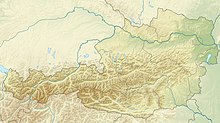| Siege of Wiener Neustadt | ||||||||||
|---|---|---|---|---|---|---|---|---|---|---|
| Part of Austrian–Hungarian War (1477–1488) | ||||||||||
| ||||||||||
| Belligerents | ||||||||||
|
|
|
| ||||||||
| Commanders and leaders | ||||||||||
|
Hanns von Wulfestorff[2] Johann von Königsberg[3] Klemens Bachlek[2] Gandolf von Khünburg[2] Bernard von Westernacher[2] Hugo von Grafeneck[2] Ruprecht von Reichenberg[3] Albert the Bold[3] |
Matthias Corvinus Emeric Zápolya Wilhelm Tettauer Bartholomew Drágffy of Beltiug Jacob Szekler Ladislaus Kanizsay Peter Geréb of Vingard Matthias Geréb of Vingard Stephen V Báthory[3] | Johann Siebenhirter[1] | ||||||||
| Units involved | ||||||||||
|
Imperial Army Saxon Army | Black Army of Hungary | Knights of St. George | ||||||||
| Strength | ||||||||||
|
Reinforcements of Johann von Königsberg: 300 cavalry Reinforcements of Ruprecht von Reichenberg: 1,800 cavalry 200 foot soldiers [3] 3,000 Saxon men-at-arms |
8,000 foot soldiers 20,000 cavalry 1,000 Transylvanian cavalry[4] 9,000 war wagons[3] | Unknown[1] | ||||||||
| Casualties and losses | ||||||||||
| Unknown |
500[3]+100 dead[4] 100 injured[4] | Unknown | ||||||||
| The military forces of the Order of Saint George of Carinthia started as an ally of the Holy Roman Empire but remained neutral. | ||||||||||
Location within Austria | ||||||||||
The siege of Wiener Neustad, part of the Austrian–Hungarian War, was an assault from January 1486 to August 1487 on the Austrian town of Wiener Neustadt. Launched by Matthias Corvinus, King of Hungary, the 18-month siege ended with the town's surrender and allowed Hungary to take control of the surrounding regions of Styria and Lower Austria. It was the last of a series of sieges, and followed Hungary's victory in the 1485 Siege of Vienna. The broader war ended less than a year later with an armistice in 1488.
- ^ a b c Béla Dezsényi; Pál Bélley; et al. (1960). "Peraudi's two printed letters of indulgence in the Hungarian National Archives I.". Az Országos Széchényi Könyvtár Évkönyve 1959 [Yearbook of the National Library Széchenyi 1959.] (in Hungarian). Budapest, Hungary: Országos Széchényi Könyvtár. pp. 279–91. Retrieved 4 July 2011.
- ^ a b c d e Anton Ferdinand von Geissau (1805). Geschichte der Belagerung Wiens durch den König Mathias von Hungarn, in den Jahren 1484 bis 1485 [History of the siege of Vienna by King Matthias of Hungary from 1484 to 1485] (in German). Wien, Austria: Anton Strauss. p. 54. Retrieved 1 July 2011.
- ^ a b c d e f g József Bánlaky (1929). "b) Az 1483–1489. évi hadjárat Frigyes császár és egyes birodalmi rendek ellen. Mátyás erőlködései Corvin János trónigényeinek biztosítása érdekében. A király halála." [B. The campaign of 1483–1489 against Frederick and some imperial estates. Struggle of Matthias to secure the throne for John Corvin. The death of the King.]. A magyar nemzet hadtörténelme [Military history of the Hungarian nation] (in Hungarian). Budapest, Hungary: Grill Károly Könyvkiadó vállalata. ISBN 963-86118-7-1. Retrieved 27 June 2011.
- ^ a b c Cite error: The named reference
Bonfiniwas invoked but never defined (see the help page).

